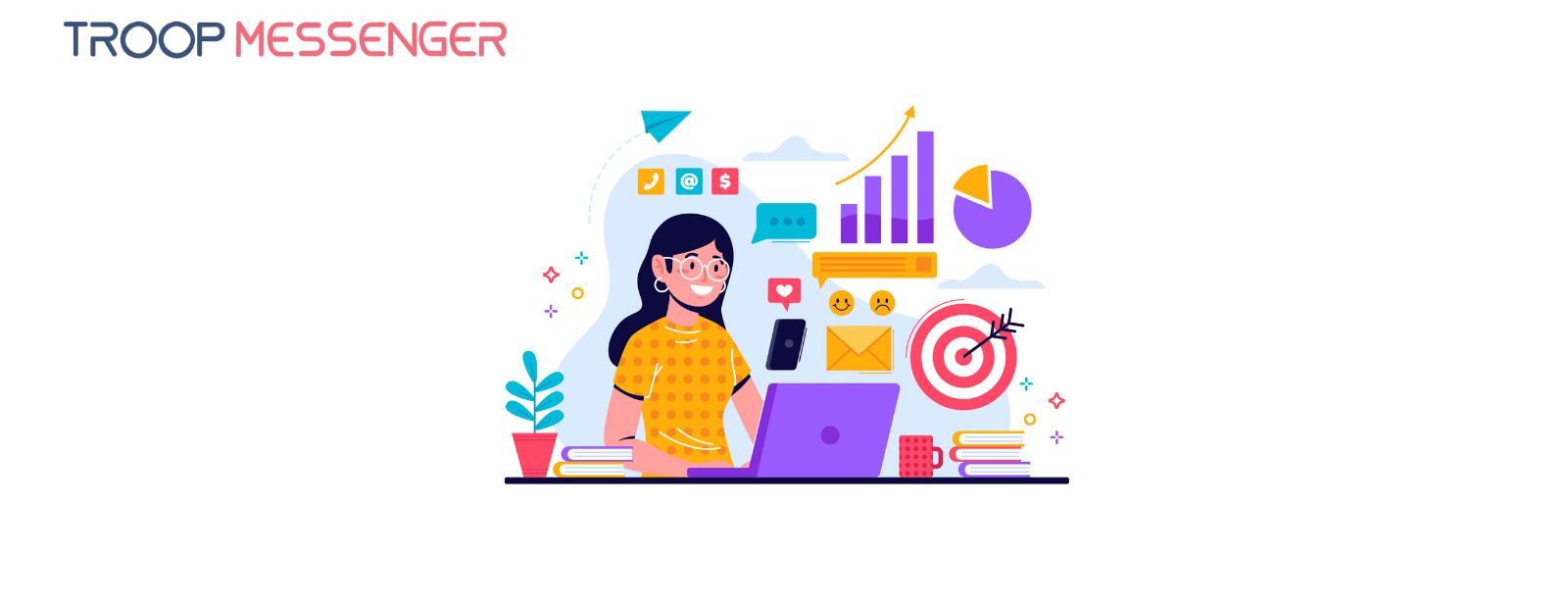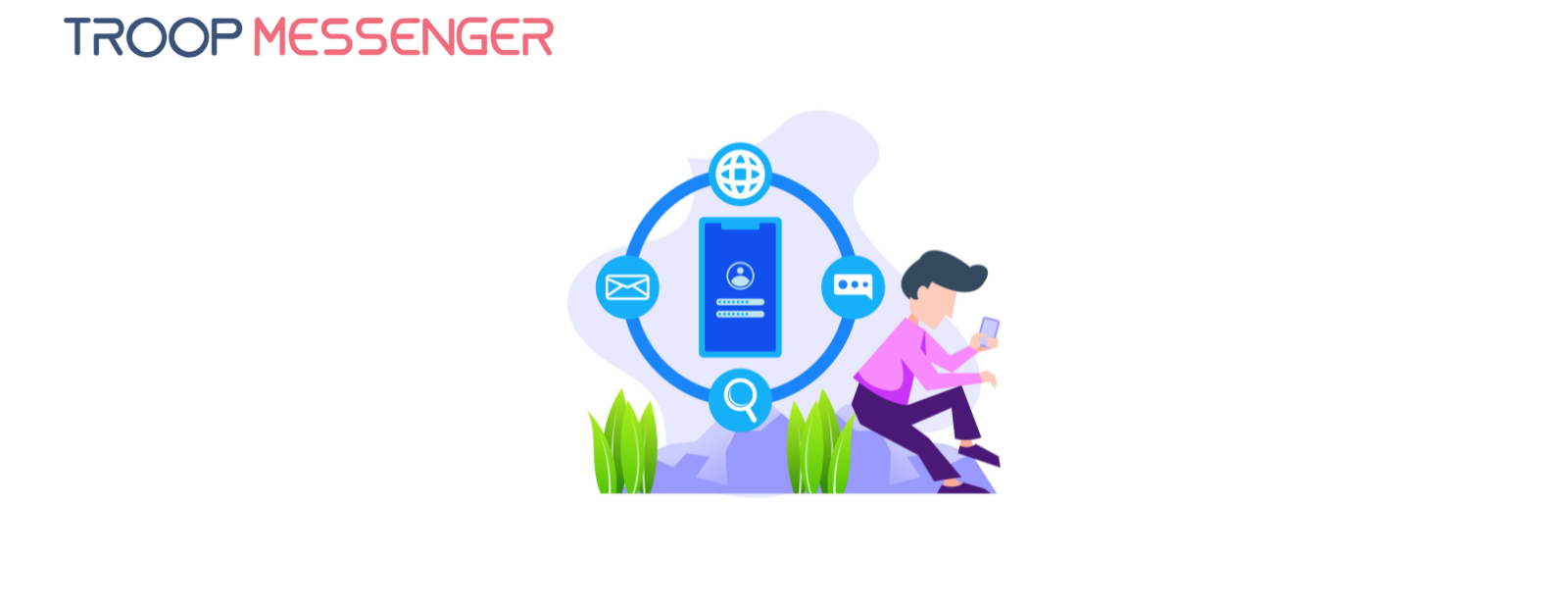Connect with us

Ryver vs Slack: Which Platform Made Collaboration Simple! [2023 Update]
We knew that you have already read a few articles from our Troop Messenger blog store on Slack alternatives.
So far we have made comparison blogs on Slack vs Microsoft Teams, Slack vs Yammer, Slack vs Discord, etc., to make you understand the insights of both tools.
Having said that, we have added one more to our store, and that is Slack vs Ryver.
Table of Contents
- Quick Infographic Comparison between Ryver vs Slack
- Ryver vs Slack: Introduction
- Ryver vs Slack: Getting Started
- Ryver vs Slack: Conversation (Messaging, audio, video call)
- Ryver vs Slack: Integrations
- Ryver vs Slack: Task Management
- Ryver vs Slack: Channels and Forum
- Ryver vs Slack: Pricing
- Ryver vs Slack: Support
- Conclusion
Quick Infographic Comparison between Ryver vs Slack
Ryver vs Slack: Introduction
Ryver
The USP of business messaging applications is -Interact less and collaborate more. Among the plethora of such tools, Ryver stands tall both in terms of cost and efficiency. This tool ranks as one of the most searched ones across the USA for its fame.
Pat Sullivan, CEO of Ryver Team Communication says Ryver has been specially designed for teams, enterprises, and IoT networks with solid features of security embedded. The Ryver website offers live chat support for all its users to answer a wide array of user queries in order to provide smooth communication across teams.
Slack
Slack brings teams together to make them communicate on project discussions, task updates, and delivery deadlines, and to ascertain quite a lot more daily office routines. It is launched in the year 2013 by Stewart Butterfield. Slack is an acronym that expands to “Searchable Log of All Conversation and Knowledge”, but across continents, it is widely known as Slack.
Slack stands as the best collaborative software that moves work forward across teams in organizations.
Ryver vs Slack: Getting Started
Ryver
Ryver comes with a free 14-day fully functional trial to create a new Ryver organization. Whoever is interested to be a part of Ryver can join by Clicking on the ‘Start for Free’, tab on their website home page to get registered to the application. It insists the users fill up the registration form with the basic details and a valid email id to send a verification mail.
The new users will also be receiving a direct message through the mail from Eddy Bot to help them get a great Ryver experience. This free trial lets the admin add unlimited users, with a provision for extending usage after the trial period by contacting the Support Team.
Slack
Slack would definitely be a great choice to opt for when it comes to team collaboration across small and medium-sized companies, as it allows its free trial for an unlimited amount of time, though with a depleted set of features. Slack users can directly log in to the application with their workspace name.
The project name users give at the time of the Sign-up process is seen as a channel on the home page of the Slack interface. Slack users have the privilege to switch between the workspaces from within the interface itself.
Our Verdict:
The Signup process for Ryver seems to be a little confusing and tedious when compared to Slack.
Ryver vs Slack: Conversation (Messaging, audio, video call)
Ryver
Conversations in Ryver happen through direct messaging, Teams, and Forums. The “Start Here”, roster tab which is seen on the home page makes the user's chat visible to all organization members and guests. To have endless chat conversations among team members, the admin is allowed to add people to the organization by sending them an invite to join Ryver.
Ryver facilitates the users to create Forums and Teams to interact dynamically on a wide range of projects and tasks. The Roster “Start Here”, tab shows “JOINED ORG ADMINS, JOINED MEMBERS and BOTS” at the right panel of the home page to easily identify the list of admins and members.
Messaging can take place across;
Ryver’s Forums - Members and guests join the conversations to participate and view activities.
- Teams - allow only team members to participate and view activity.
- Ryver says, “Private teams are a great way to have a group of people focus on a project, topic, or assignment.” Ryver allows voice and video calls across direct messaging, teams, and forums.
Slack
Messaging across Slack takes place through direct messages, channels, and threads. The users can directly interact with Slackbot for all kinds of help/assistance.
If in case it couldn’t answer the user queries, it will search for the help center to assist them further.
The sender can open the chat window of the recipient user from the member's list to initiate a one-on-one conversation with the chat support features;
- Add reaction
- Share link
- Attach files
- Star message
- Delete message
- Mark unread
- Show conversation details
- Voice and video calls
- Conversation settings and many more.
Our Verdict:
Conversations across Slack and Ryver happens through messaging, audio, and video call. Slack is easy to use than Ryver.
The similar post you might like:
Ryver vs Slack: Integrations
Ryver
This application supports a wide array of integrations presenting the best user experience!
Dive into the world of integrations from the user's profile drop-down window of the Ryver home page. Ryver, in association with Zapier, supports 1500 integrations along with a good number set of custom integrations to make users super productive.
Slack
Slack comes with a tagline of “Add apps, get work done” on its app directory page. The user needs to navigate to this page from, “Browse Apps”, a section of the Slack home page where they are further allowed to manage custom integrations too.
With a diverse range of app integrations, the users of the Slack team collaboration tool can pull reports, start making calls, file support tickets, have face-to-face video conferencing, and more right within Slack.
Pros and Cons of Integrations:
- Integrations make a great way to help users enhance the quality of the application.
- A wide range of apps can be integrated into Slack and Ryver to address every need of the user.
- The only disadvantage would be the process of integration that the users have to undergo.
Our Verdict:
App Integration Process in Slack seems to be much easier than Ryver.
Ryver vs Slack: Task Management
Ryver
Task Management at Ryver is simply awesome!
It allows users to create unlimited tasks to help them process better solutions. The feature of the team and personal task boards enable the users to personalize them according to their project requirements. This feature allows you to break down your project into various tasks and presents a complete view of each of them.
The task stream section that is available on the left navigation bar gives us an overview of all the latest tasks.
Slack
Slack allows its users to integrate with a wide range of project management tools like Asana, Trello, Jira, etc., to keep all your projects on track. Slack to-do lists in channels enable all the team members to view all the tasks in one place to have an easy understanding and flexible workflow.
Automation of tasks is said to be one of the unique features of Slack. We can “time” Slack to send automated task reminders through notifications.
Our Verdict:
Comprehensive and built-in task management and workflow automation process are available in Ryver, whereas in Slack this facility can be only achieved through integrations.
Ryver vs Slack: Channels and Forum
Ryver Forums
All open discussions happen in Ryver’s Forums.
Forums allow individuals, teams, and guests to join and participate in team decision-making and discussions. These Forums are almost similar to Slack’s channels. The Slack Migration Tool enables Ryver to import Slack users, messages, files, and posts into Ryver. You can find the “Forums” on the left panel of Ryver’s home page.
As a user of Ryver, you are supposed to join a Forum to avail the services provided by it. The users have the privilege to join and leave Forums at their interest.
Slack Channels
Slack facilitates leverage to create public and private channels. While in the public channels, any users of the workspace will be able to view and join channels. Whereas in private channels only invitees are supposed to view and interact with others. Slack allows having up to 1000 people in each channel.
The users of Slack can find all the channels grouped at the left navigation bar of the home page.
Ryver vs Slack: Pricing
Ryver
Ryver comes with the pricing plans of
- Starter - $49/month
- Unlimited - $99/month
- Enterprise - $399/month
The first two plans start as a free 14-day trial offer. The starter plan has been built for up to 12 users with the features of unlimited chat, unlimited file sharing, task management, etc.,
The second plan which is the most popular of all three is meant for unlimited users with the features of custom invite links, unlimited chat, unlimited file sharing, task management, voice, and video calls, etc., An advanced feature of workflow automation, single sign-on, premium support, advanced team management, testing sandbox and with all other features of Starter and Unlimited are seen in Ryver’s Enterprise plan.
Slack
Slack comes with the pricing plans of
- Free - $0 (Storage per member- 5 GB)
- Standard - $6.67/month (Storage per member - 10 GB)
- Plus - $12.50/month (Storage per member - 20 GB)
- Enterprise Grid (Storage per member - 1TB)
The free plan of Slack comes with 10k searchable messages, 10 app integrations, one-to-one video calls, and two-factor authentication for an unlimited amount of time. The other plans would include Standard, Plus, and Enterprise Grid.
Ryver vs Slack: Support
Ryver
Ryver extends great support to its users. The support website page welcomes the user with Eddy Bot. A detailed quick start guide for navigating the Ryver, a user guide for providing an overview of the Ryver, a technical guide to assist users on external integrations, Slack import tool, Developer APIs, etc.,
Ryver further allows live chat and help support to attend to all user queries with the utmost ease. It facilitates the users to share their product ideas and requests for new features with the Ryver team from the support webpage.
Slack
The slack team extends a well co-ordinated and collaborative customer support to all its users. The support teams resolve issues and share knowledge of the product. It allows users to collaborate with more powerful integrations to achieve faster customer query resolutions.
It lets you post support tickets in channels themselves only, thereby not letting you leave it to track their status on them.
Conclusion
Team collaboration applications are a must-have for any kind of organization. Be it small, medium, or large type of organizations, there is an utter need for people to interact with each other on diverse projects and tasks to achieve success and within time schedules. Ryver and Slack, both have their own set of pros and cons in extending team collaboration.
Disclaimer
The article aims to be informative. We intend for users to take an informed decision for an effective and productive experience. The comparison shown between Ryver vs slack in the blog is only towards that end and has no intention of pitting one against the other team collaboration app brands. The images, logos, any concepts, etc., used in this blog, purely belong to their respective companies or applications (Ryver and Slack).
Readers are advised to consult and confirm with the respective service providers regarding details of features, the latest updates, prices, and policies before utilizing any of their services.
This further informs the reader that the views, thoughts, and opinions expressed in this blog solely belong to the author’s perception, and not necessarily to the author’s employer, organization, committee, or other group or individual.









